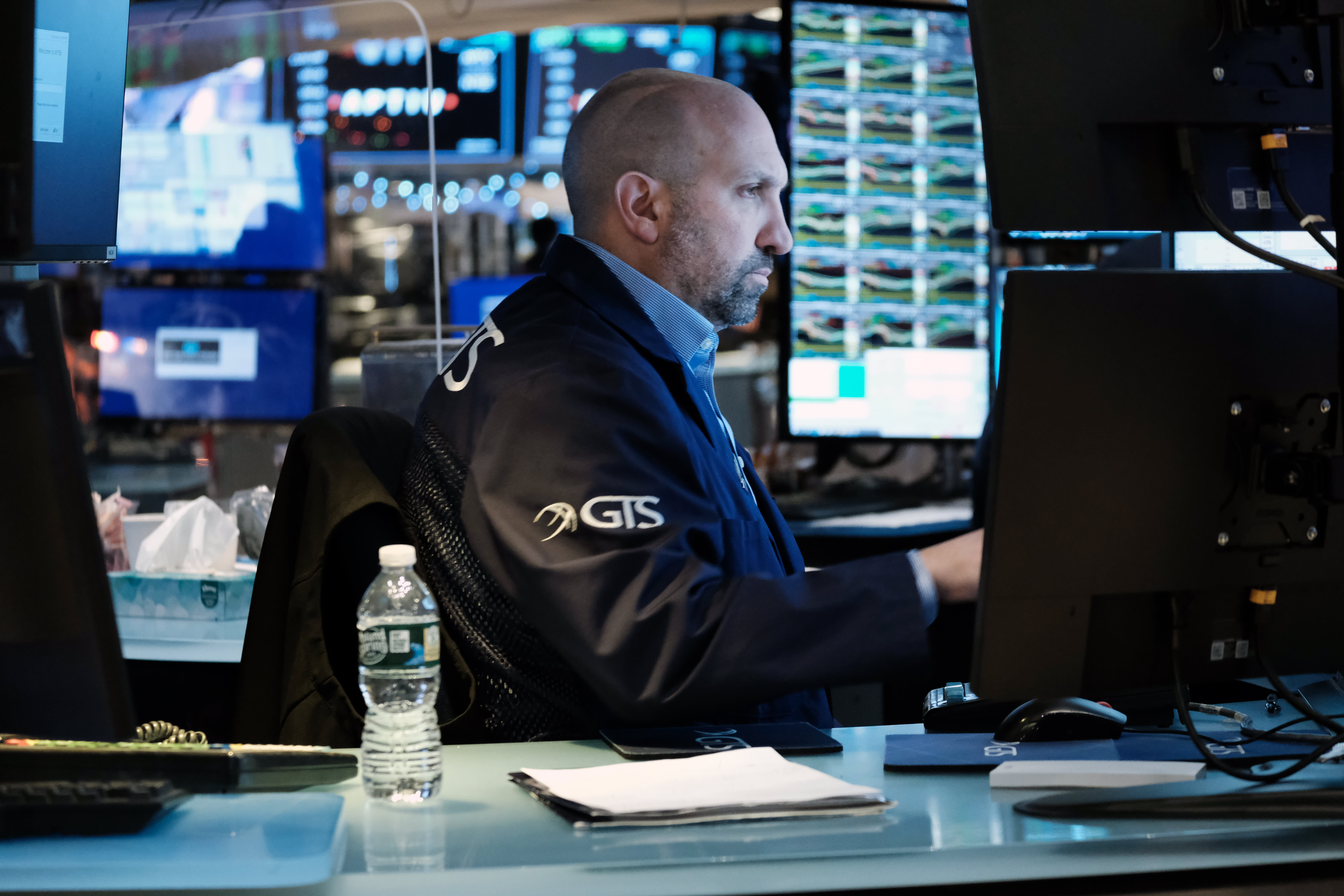
The Dow Jones Industrial Average jumped on Monday and the Nasdaq Composite lagged as investors looked past the emerging threat from the omicron Covid-19 variant, rotating out of high-priced technology shares and into names linked to the recovering economy.
Here’s what was influencing the markets to start the week:
- Shares linked to the economic reopening gained in Monday trading like energy, industrials and airlines.
- Investors continued to sell tech stocks with relatively high valuations. Those shares dragged the market down to a losing week on Wall Street last week.
- The 10-year Treasury yield rebounded after falling last week amid the omicron threat.
- There’s a major shift underway at the Federal Reserve to bring about a faster end to its pandemic easing policies.
- Bitcoin lost $10,000 since Friday, including a sudden drop overnight from Friday to Saturday. The move showed decreasing risk appetite and is hitting related tech stocks.
The Dow gained 576 points, or 1.7%, while the Nasdaq Composite clawed back losses from earlier in the morning and climbed 0.9%. The S&P 500 was higher by 0.3%.
High-priced tech shares were lower, continuing a de-risking theme in markets. Nvidia was off by 5% while Tesla fell 2%. Microsoft and Alphabet were also lower.
“Super-cap tech has been well bid on the expectation of ‘forever’ low rates and support,” said Tom Essaye, author of the Sevens Report, “but with the prospect of rates rising and this new Fed paradigm, we are seeing investors rotate out of tech and into sectors with better exposure to higher growth.”
He added that it was comments from the Fed that pulled the market back late last week, and not fears about the omicron variant.
“Tech pulled the entire market lower. Essentially, we are seeing a sort of Taper Tantrum 2.0 as markets react to a more hawkish Fed and rotate into sectors with more positive exposure to rising rates,” Essaye said.
Last week, Fed Chair Jerome Powell unnerved markets by signaling the Fed’s focus is inflation, even with the new variant emerging.
Comments by Fed officials suggest that the Fed is likely to decide to double the pace of its taper to $30 billion a month at its meeting next week, CNBC’s Steve Liesman reported on Monday. Initial discussions could also begin as soon as the December meeting about when to raise interest rates and by how much next year.
Stocks linked to the reopening of the economy gained on Monday, boosting sentiment on the Dow. Boeing and Chevron shares were in the green.
United and Delta Airlines shares jumped about 5%. Carnival gained almost 3% and Wynn Resorts shares were up by about 2%.
U.S. Bank Wealth Management’s Tim Hainlin said investors are also focused on what the terminal interest rate will be, and added he expects it to be lower that what investors are pricing in.
“The long-term growth rate is challenged by factors that are changing — demographics, productivity and longer-term growth in the labor force — and drive the economy in the long-term,” he told CNBC. “We still think those are muted relative to history, so the idea that the Federal Reserve would raise rates up until up to a rate that we’ve historically seen — we think that it’s not likely to get up to that level.”
On Friday, the Nasdaq Composite slid 1.92% with shares of Tesla as the biggest drag. Cathie Wood’s flagship Ark Innovation Fund fell more than 5% Friday, and all of the fund’s holdings are now in a bear market apart from two stocks. Teladoc Health, Zoom Video, Roku, Palantir and Twilio are some of the names that have registered steep losses.
Bitcoin traded around $57,000 on Friday morning, but by Saturday had plunged to around $43,000. By Monday the world’s largest cryptocurrency had clawed back some of its losses, last trading at around $47,377.
Shares of Coinbase lost about 5%, while Square declined by more than 2%.
Loading chart…
Slower-than-expected job growth also contributed to Friday’s selling. Nonfarm payrolls increased by 210,000 last month, the Labor Department said Friday, which was below the 573,000 number economists surveyed by Dow Jones were expecting.
“A softer payrolls print pulled the rug beneath risk sentiment,” TD Securities wrote Friday in a note to clients. As investors fled to safety the yield on the 10-year Treasury dipped to 1.335%, the lowest since Sept. 21.
Friday’s selling wrapped up a volatile week for the major averages as investors evaluated new information about the omicron variant.
All three major averages finished the week in the red, with the Dow registering a fourth straight negative week for the first time since September 2020. The S&P and Nasdaq Composite were both down for a second consecutive week.
Small cap names were hit especially hard, with the Russell 2000 falling 3.86% for the week.
“Despite our forecast for a flat year for the S&P 500…we are still bullish on pockets of the market, including small caps,” Bank of America said Friday in a note to clients. “Small caps are more domestic, more exposed to the services spending recovery, bigger beneficiaries of capex/reshoring and are inexpensive vs. large caps,” the firm added.
However, Bank of America said the potential upside for small caps hinges on Covid cases staying under control.
The omicron variant has now been discovered in at least 15 U.S. states, CDC Director Dr. Rochelle Walensky told ABC News on Sunday. However, White House Chief Medical Advisor Dr. Anthony Fauci said the initial data on the omicron variant is “encouraging,” in a CNN interview the same day, which was less than two weeks after the World Health Organization designated it as being “of concern.”
“Clearly, in South Africa, omicron has a transmission advantage,” Fauci told CNN. “Although it’s too early to make any definitive statements about it, thus far it does not look like there’s a great degree of severity to it.”




